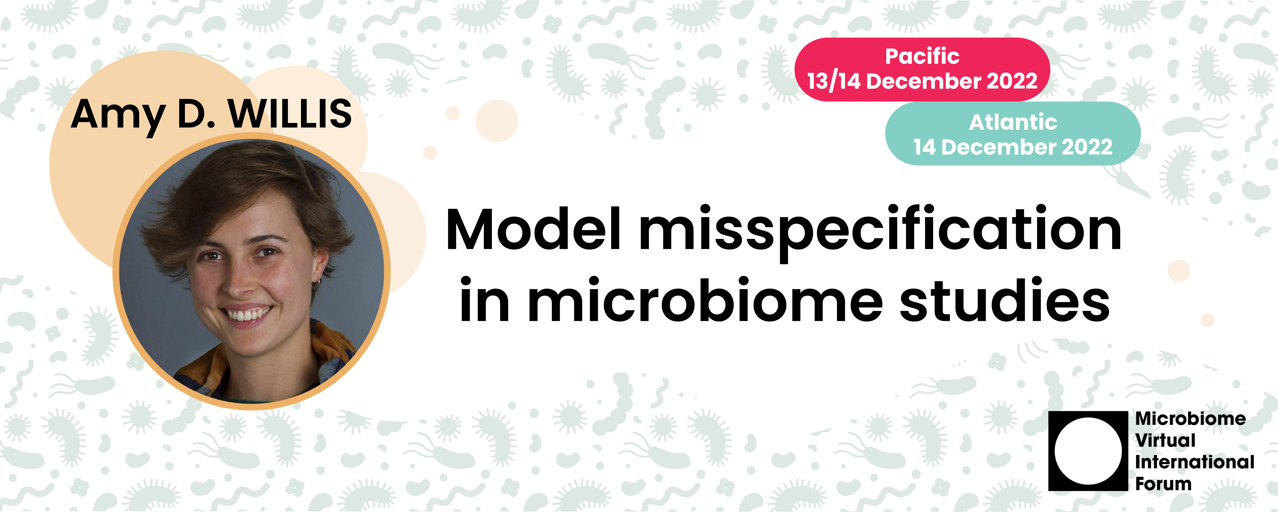Bio
Amy Willis is the Principal Investigator of the Statistical Diversity Lab and a tenure-track Assistant Professor in the Department of Biostatistics at the University of Washington. Amy and the StatDivLab develop tools for the analysis of microbiome and biodiversity data. Amy is the recipient of a NIH Outstanding Investigator Award, a UW Outstanding Faculty Mentor Award, and a UW Outstanding Faculty Teaching Award.
Abstract
The relative abundances of bacterial species in a microbiome are an important parameter to estimate given the critical role that microbiomes play in human and environmental health. We show that high-throughput sequencing distorts the true composition of microbial communities, and propose a statistical model that reflects this observation. Our model can be leveraged to select experimental protocols, design experiments with appropriate control data, and remove sample-specific contamination.
Selected talks
mEnrich-seq: Methylation-guided enrichment sequencing of bacterial taxa of interest from microbiome
Metagenomics has enabled the comprehensive study of microbiomes. However, many applications would benefit from a method that can sequence specific bacterial taxa of interest (pathogens, beneficial microbes, or low-abundance taxa), but not the vast background of other taxa in a microbiome sample. To address this need, we developed mEnrich-seq, a method that can enrich taxa of interest from metagenomic DNA before sequencing. The core idea is to exploit the self vs. non-self genome differentiation provided by natural bacterial DNA methylation and rationally choose methylation-sensitive restriction enzymes (REs), individually or in combination, to deplete host DNA and most background microbial DNA while enriching bacterial taxa of interest. This core idea is integrated with library preparation procedures in a way that only non-digested DNA libraries are sequenced. We performed in-depth evaluations of mEnrich-seq and demonstrated its use in several applications to enrich (up to 117-fold) genomic DNA of pathogenic or beneficial bacteria from human urine and fecal samples, including several species that are hard to culture or of low abundance. We also assessed the broad applicability of mEnrich-seq and found that 3130 (68.03%) of the 4601 strains with mapped methylomes to date can be targeted by at least one commercially available RE, representing 54.78% of the species examined in this analysis. mEnrich-seq provides microbiome researchers with a versatile and cost-effective approach for selective sequencing of diverse taxa of interest directly from the microbiome.
Link to OA paper: https://www.biorxiv.org/content/10.1101/2022.11.07.515285v1
Lei Cao, Yimeng Kong, Yu Fan, Mi Ni, Alan Alan Tourancheau, Magdalena Ksiezarek, Edward Andy Mead, Tonny Koo, Melissa Gitman, Xue-Song Zhang, Gang Fang
Presenting author affiliation: Department of Genetics and Genomic Sciences, Icahn School of Medicine at Mount Sinai, New York, NY 10029, USA
Dynamic changes in small intestinal stoma microbiota
Ileum has a distinct microbiota but human studies investigating its composition and function have been limited by the inaccessibility of the ileum without purging and/or deep intubation. In this recently published study, we investigated inherent instability, temporal dynamics, and the contribution of fed to the otherwise inaccessible small and large intestines. Longitudinal samples from the ileum before and after stoma formation indicated that ileostoma microbiotas represented that of the intact small intestine. Ileal and colonic stoma microbiotas were confirmed as distinct, and two types of instability: i) inter-digestive purging followed by the rapid postprandial blooming of bacterial biomass and sub-strain appearance and ii) disappearance within individual taxa after feeding. In contrast to the relative stability of colonic microbiota, small intestinal microbiota biomass and its sub-strain composition can be highly dynamic.
Link to OA paper: https://www.sciencedirect.com/science/article/pii/S1931312822005157?dgcid=coauthor
Bahtiyar Yilmaz
Presenting author affiliation: Inselspital, Department for Biomedical Research, University of Bern
Effect of the intratumoral microbiota on spatial and cellular heterogeneity in cancer
The tumour-associated microbiota is an intrinsic component of the tumour microenvironment across human cancer types. Intratumoral host–microbiota studies have so far largely relied on bulk tissue analysis, which obscures the spatial distribution and localized effect of the microbiota within tumours. Here, by applying in situ spatial-profiling technologies and single-cell RNA sequencing to oral squamous cell carcinoma and colorectal cancer, we reveal spatial, cellular and molecular host–microbe interactions. We adapted 10x Visium spatial transcriptomics to determine the identity and in situ location of intratumoral microbial communities within patient tissues. Using GeoMx digital spatial profiling, we show that bacterial communities populate microniches that are less vascularized, highly immuno suppressive and associated with malignant cells with lower levels of Ki-67 as compared to bacteria-negative tumour regions. We developed a single-cell RNA-sequencing method that we name INVADEseq (invasion–adhesion-directed expression sequencing) and, by applying this to patient tumours, identify cell-associated bacteria and the host cells with which they interact, as well as uncovering alterations in transcriptional pathways that are involved in inflammation, metastasis, cell dormancy and DNA repair. Through functional studies, we show that cancer cells that are infected with bacteria invade their surrounding environment as single cells and recruit myeloid cells to bacterial regions. Collectively, our data reveal that the distribution of the microbiota within a tumour is not random; instead, it is highly organized in microniches with immune and epithelial cell functions that promote cancer progression.
Link to OA paper: https://www.biorxiv.org/content/10.1101/2022.11.07.515285v1
Jorge L Galeano Niño, Hanrui Wu, Kaitlyn LaCourse, Andrew Kempchinsky, Alexander Baryiames, Brittany Barber, Neal Futran, Jeffrey Houlton, Cassie Sather, Ewa Sicinska, Alison Taylor, Samuel Minot, Christopher Johnston
Presenting author affiliation: Human Biology Division, Fred Hutchinson Cancer Center, Seattle, WA, USA
Research Highlights:
Time of Sample Collection Critical for Microbiome Replicability
Although many aspects of microbiome studies have been standardized to improve experimental replicability, none account for how the daily diurnal fluctuations in the gut lumen cause dynamic changes in 16S amplicon sequencing. Here we show that sample collection time affects the conclusions drawn from microbiome studies and are larger than the effect size of a daily experimental intervention or dietary changes. The timing of divergence of the microbiome composition between experimental and control groups are unique to each experiment. Sample collection times as short as only four hours apart lead to vastly different conclusions. Lack of consistency in the time of sample collection may explain poor cross-study replicability in microbiome research. Without looking at other data, the impact on other fields is unknown but potentially significant.
Link to OA paper: https://www.biorxiv.org/content/10.1101/2022.10.26.513817v1
Celeste Allaband, Amulya Lingaraju, Stephany Flores Ramos, Tanya Kumar, Haniyeh Javaheri, Maria Denalene Tiu, Ana Carolina Dantas Machado, Roland Alexander Richter, Emmanuel Elijah, Gabriel G Haddad, Vanessa A Leone, Pieter Dorrestein, Rob Knight, Amir Zarrinpar
Presenting author affiliation: University of California San Diego
Longitudinal analysis at three oral sites links oral microbiota to clinical outcomes in allogeneic hematopoietic stem-cell transplant
Background Allogeneic hematopoietic stem-cell transplant (allo-HSCT) is a potentially curative therapy for several hematological disorders. Before stem-cell infusion, recipients undergo a conditioning regimen with chemo/radiotherapy and immunosuppressants, requiring the use of antibiotics to treat and prevent infections. This regimen promotes drastic alterations in the recipient′s microbiotas, including the oral microbiota, which have been associated with allo-HSCT complications and poor outcomes. However, long-term longitudinal studies on the oral microbiota of allo-HSCT recipients are scarce and disregard the existence of distinct microbiotas within the oral cavity. Here, we used 16S rRNA gene sequencing to characterize the microbiota dynamics (during and after allo-HSCT) of 31 allo-HSCT recipients at 3 oral sites (gingival crevicular fluid, oral mucosa, and supragingival biofilm). Results Analysis of the oral microbiota dynamics during allo-HSCT revealed a significant decline in bacterial diversity and major shifts in microbiota composition in all oral sites, including blooms of potentially pathogenic genera. These blooms in some cases preceded respiratory infections caused by the blooming genera. We also noticed that differences in microbiota diversity and composition between oral sites were lost during allo-HSCT. Overall, oral microbiotas returned to their preconditioning state after engraftment. However, the ability to recover the initial bacterial composition varied between patients. After stratifying patients based on their ability to recover their preconditioning microbiota composition, we found that recovery of the oral mucosa microbiota composition was not associated with antibiotic usage but was associated with higher preconditioning diversity and earlier reconstitution of normal leukocyte counts. Most notably, oral mucosa microbiota composition recovery was an independent biomarker of better allo-HSCT outcomes. Conclusion We observed clear patterns of microbiota dysbiosis in all three oral sites during allo-HSCT, however each oral site responded differently to the perturbations associated with allo-HSCT. Oral microbiota injury and recovery patterns were associated with allo-HSCT complications and outcomes. This study highlights the potential clinical impact of the oral microbiota in the allo-HSCT setting and the clinical value of tracking oral microbiota changes during allo-HSCT.
Link to OA paper: https://www.medrxiv.org/content/10.1101/2022.11.18.22282520v1
Vitor Heidrich, Franciele H. Knebel, Julia S. Bruno, Vinícius C. de Molla, Wanessa Miranda-Silva, Paula F. Asprino, Luciana Tucunduva, Vanderson Rocha, Yana Novis, Eduardo R. Fregnani, Celso Arrais-Rodrigues, Anamaria A. Camargo
Presenting author affiliation: Centro de Oncologia Molecular, Hospital Sírio-Libanês, São Paulo, SP, Brazil; Departamento de Bioquímica, Instituto de Química, Universidade de São Paulo, São Paulo, SP, Brazil

